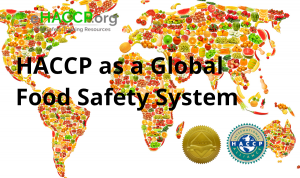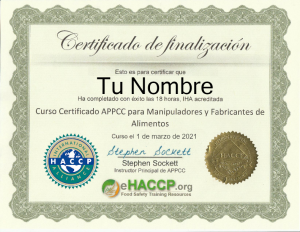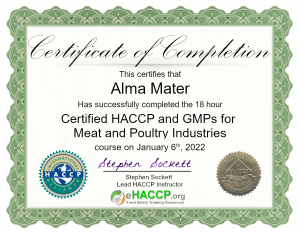HACCP - The International Standard for Food Safety
Compliance with HACCP (Hazard Analysis and Critical Control Points) regulations is essential for ensuring the safety of food production processes worldwide.
Food safety is a critical pillar in food processing, ensuring that the food reaching consumers' tables is free from contaminants and safe to eat. The importance of maintaining high standards of food safety cannot be overstated, as it directly impacts public health, consumer confidence, and economic stability. Foodborne illnesses can result in severe health consequences, including hospitalization and even death. Therefore, rigorous food safety protocols are essential to prevent the contamination of food products with pathogens such as Salmonella, E. coli, and Listeria.
In addition to protecting public health, stringent food safety measures help maintain the integrity and reputation of food manufacturers. A single outbreak linked to a company's product can lead to devastating financial losses due to recalls, legal liabilities, and damage to brand trust. Moreover, in an increasingly globalized market where supply chains span multiple countries and continents, harmonizing food safety standards like HACCP1 (Hazard Analysis Critical Control Point) ensures consistency and reliability across borders.
Ultimately, prioritizing food safety in processing not only safeguards consumers but also upholds the sustainability of the global food industry by fostering a culture of vigilance and responsibility at every stage of production.
Understanding Quality Control In The Food Industry
Quality control in the food industry is a multifaceted approach aimed at ensuring products meet predefined safety and quality standards. It involves systematic measures that monitor and regulate various stages of food production, from raw material sourcing to final product distribution. Central to this process are stringent protocols for hygiene, handling, processing, and storage. These measures help prevent contamination and ensure consistency in taste, texture, and nutritional value.
In the food industry, quality control is not merely about end-product testing but encompasses every aspect of production. This holistic view integrates hazard analysis, risk assessment, and preventive measures to mitigate potential issues before they arise. Quality control systems rely heavily on both scientific principles and regulatory guidelines to establish critical control points where interventions can be applied effectively.
Technological advancements have further enhanced quality control by enabling real-time monitoring and data analysis. Tools such as automated sensors and blockchain for traceability have made it easier to maintain high standards across complex supply chains.
Understanding these elements is crucial for maintaining consumer trust and meeting regulatory requirements. Effective quality control ensures that food products are safe for consumption while also upholding the brand's reputation in a highly competitive market.
HACCP: The International Standard for Food Safety
Compliance With HACCP Regulations for Safe Food Production
Compliance with HACCP (Hazard Analysis and Critical Control Points) regulations is essential for ensuring the safety of food production processes worldwide. This systematic approach to food safety focuses on identifying, evaluating, and controlling hazards that could compromise the integrity of food products. The implementation of HACCP principles is not merely a recommendation but a regulatory requirement in many countries, underscoring its significance in global food safety standards.
To comply with HACCP regulations, food producers must first conduct a thorough hazard analysis. This involves identifying potential biological, chemical, and physical hazards that could occur at various stages of the production process. By understanding where risks lie, producers can develop targeted strategies to mitigate these hazards effectively. This initial step is crucial because it lays the foundation for all subsequent actions within the HACCP framework.
Once hazards have been identified, establishing critical control points (CCPs) becomes imperative. CCPs are specific stages in the production process where controls can be applied to prevent or eliminate hazards or reduce them to acceptable levels. Compliance requires meticulous documentation and validation of these control measures to ensure they are effective under operational conditions.
Monitoring procedures must be put in place at each CCP to track compliance continuously. This involves regular observations or measurements to confirm that control measures are functioning as intended. For example, temperature controls might be monitored during cooking processes to ensure pathogens are destroyed adequately. Consistent monitoring helps detect deviations promptly so corrective actions can be taken before unsafe products reach consumers.
Corrective actions form another vital component of compliance with HACCP regulations. When monitoring indicates that a critical limit has been breached at a CCP, immediate steps must be taken to rectify the situation and prevent potentially hazardous products from entering the market. These actions might include adjusting processing parameters or implementing additional safety checks.
Verification activities also play an essential role in maintaining compliance with HACCP standards. Verification ensures that all aspects of the HACCP plan are being followed correctly and effectively over time. This may involve reviewing records, conducting audits, or performing additional testing on final products.
Record-keeping is an integral part of demonstrating compliance with HACCP regulations as well. Detailed documentation provides evidence that all required procedures have been followed diligently and allows for traceability if issues arise later on.
Training personnel involved in food production about HACCP principles and practices is equally important for maintaining compliance. Employees need to understand their roles within the system fully so they can perform their tasks accurately and consistently. ehaccp.org offers IHA accredityed HACCP training and certification.
In conclusion, complying with HACCP regulations requires a comprehensive approach encompassing hazard analysis, establishment of critical control points, continuous monitoring, prompt corrective actions when necessary, regular verification activities, meticulous record-keeping, and thorough training programs for all personnel involved in food production processes. Adhering to these rigorous standards ensures safer food products globally while fostering consumer trust and confidence in the industry's commitment to public health.
How HACCP Ensures Consistent Quality in the Global Market
HACCP (Hazard Analysis and Critical Control Points) ensures consistent quality in the global market by establishing a systematic approach to identifying, evaluating, and controlling food safety hazards. This methodology is universally recognized and adopted, creating a common language and set of expectations for food safety across borders. By focusing on critical control points in the production process, HACCP allows manufacturers to pinpoint potential risks and implement preventive measures tailored to their specific operations.
This not only minimizes the likelihood of contamination but also standardizes processes, ensuring that products meet consistent quality standards regardless of where they are produced or consumed.
The rigor of HACCP protocols means that each step in the food production chain is monitored and verified. From raw material sourcing to final product distribution, every phase undergoes scrutiny to ensure it complies with predefined safety criteria. This detailed oversight reduces variability, fostering a reliable level of quality that consumers can trust globally. Moreover, because HACCP is built on scientific principles and continuous improvement practices, it evolves with emerging threats and technological advancements, maintaining its relevance in an ever-changing global market while safeguarding public health consistently.
The Significance of International Standards for Food Safety
The significance of international standards for food safety cannot be overstated in today's globalized world. As food supply chains become increasingly intricate, spanning multiple countries and continents, the need for a unified approach to ensuring food safety becomes paramount. International standards, such as those set by the Codex Alimentarius Commission, provide a universally recognized framework that helps harmonize regulations across borders.
This harmonization is critical not only for protecting consumer health but also for facilitating international trade.
When countries adopt consistent food safety protocols, it reduces the risk of contamination and foodborne illnesses that can arise from disparate practices. This is particularly important given the diverse agricultural practices and regulatory environments around the world. Moreover, international standards help build trust among consumers who are more likely to purchase products knowing they meet stringent safety criteria regardless of their origin.
For businesses, adhering to these standards can open up new markets and reduce barriers to entry in foreign countries. By aligning with globally recognized guidelines like HACCP (Hazard Analysis Critical Control Point), companies demonstrate their commitment to high-quality and safe products, fostering greater confidence among international buyers and regulators alike.
Implementing HACCP: Steps To Achieving Compliance
Implementing Hazard Analysis and Critical Control Points (HACCP) is a systematic approach to ensuring food safety that requires meticulous planning and execution. The first step in achieving HACCP compliance involves assembling a multidisciplinary team with expertise in various aspects of the food production process, such as microbiology, engineering, and quality control. This team is responsible for conducting a thorough hazard analysis to identify potential biological, chemical, and physical hazards that could compromise food safety.
Following hazard identification, the team must determine Critical Control Points (CCPs) in the production process where controls can be applied to prevent or eliminate these hazards. Each CCP requires specific criteria or limits that must be met to ensure safety. Monitoring procedures are then established to regularly check these limits are maintained.
Corrective actions must be clearly defined for instances when monitoring indicates a deviation from established limits. Verification processes are essential for confirming that the HACCP system is effective and functioning as intended. Finally, comprehensive documentation and record-keeping ensure traceability and accountability throughout the entire process.
By meticulously following these steps, organizations can achieve HACCP compliance, thereby enhancing their commitment to delivering safe food products globally.
Benefits Of Following HACCP Guidelines For Consumer Health
Implementing Hazard Analysis and Critical Control Points (HACCP) guidelines yields significant benefits for consumer health. Foremost among these is the substantial reduction in foodborne illnesses. By identifying and controlling potential hazards at every stage of food production, HACCP minimizes the risk of contamination from pathogens such as Salmonella, E. coli, and Listeria. This proactive approach ensures that food reaching consumers is safe for consumption.
Another crucial benefit is the enhancement of overall food quality. HACCP’s rigorous monitoring and control mechanisms not only target safety but also contribute to maintaining consistent quality standards. This means fewer chances of spoilage or degradation, resulting in fresher, more wholesome food products for consumers.
Additionally, adherence to HACCP guidelines fosters greater transparency and traceability within the food supply chain. In case of any health concerns or outbreaks, it becomes easier to trace the source of contamination swiftly and take corrective actions to prevent further issues.
Ultimately, following HACCP guidelines builds consumer trust in food products and brands. Knowing that stringent safety protocols are in place gives consumers peace of mind about their dietary choices, reinforcing a sense of security regarding their health and well-being.
How HACCP is Recognized Worldwide as the Gold Standard
Hazard Analysis and Critical Control Points (HACCP) is recognized globally as the gold standard for food safety due to its comprehensive, science-based approach to identifying and managing potential hazards in food production processes. The system is endorsed by international organizations such as the World Health Organization (WHO) and the Food and Agriculture Organization (FAO), which underscores its universal applicability and reliability.
HACCP's methodology involves systematically analyzing every step of the food production process, from raw material procurement to final product distribution, ensuring that potential risks are identified, assessed, and controlled.
Countries around the world have adopted HACCP principles into their national regulations, making it a fundamental requirement for businesses seeking to export their products internationally. This widespread adoption is a testament to HACCP's effectiveness in mitigating risks associated with biological, chemical, and physical hazards in food production. The system's proactive nature—focusing on prevention rather than reaction—enhances consumer confidence in food safety standards across borders.
Moreover, major global trade agreements often stipulate compliance with HACCP protocols as a prerequisite for market entry. This harmonization of standards facilitates smoother trade relations and ensures that consumers worldwide benefit from consistent levels of food safety.
The Future of Food Safety: Embracing HACCP as a Global Norm
The future of food safety lies in the global embrace of Hazard Analysis and Critical Control Points (HACCP) as the standard protocol. As international trade in food products continues to expand, the necessity for a unified, science-based approach to food safety becomes increasingly crucial. HACCP offers a systematic preventive framework that identifies potential hazards and implements control measures at critical points in the production process.
This proactive method not only ensures higher standards of safety but also fosters consumer confidence across borders.
Adopting HACCP globally means creating a common language for food safety that transcends regional regulations and disparate practices. It encourages collaboration between nations, facilitates smoother trade negotiations, and reduces barriers caused by differing food safety protocols. Furthermore, as technology advances, integrating digital monitoring tools with HACCP can enhance real-time data collection and analysis, enabling quicker responses to potential hazards.
In a world where foodborne illnesses can have rapid and far-reaching impacts, embracing HACCP universally is more than a regulatory step; it’s a commitment to safeguarding public health on an unprecedented scale. By prioritizing this comprehensive approach, we pave the way for safer consumption experiences worldwide.
Stephen Sockett
eHACCP.org
+1 8664881410
email us here
Visit us on social media:
Facebook
X
LinkedIn
YouTube
Other
WATCH NOW: Video overview of eHACCP.org. Online HACCP training and certification for food companies; producers, processors / manufacturers, meat and poultry, seafood, etc. at https://www.youtube.com/watch?v=6EOpd5X1dHo

1 http://ehaccp.org
2 https://ehaccp.org/certification/
3 https://ehaccp.org/all-courses/



